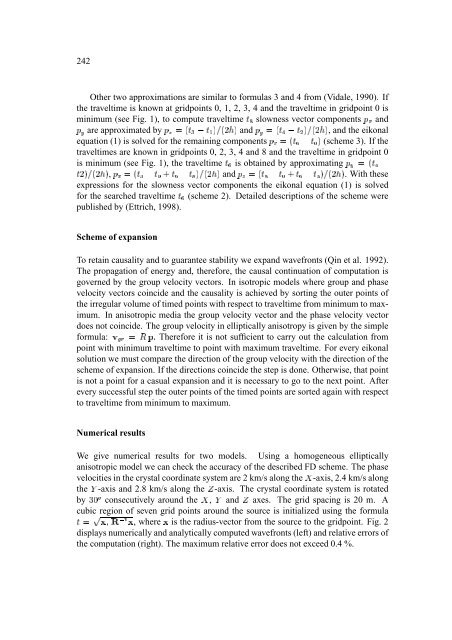Annual Report 2000 - WIT
Annual Report 2000 - WIT
Annual Report 2000 - WIT
Create successful ePaper yourself
Turn your PDF publications into a flip-book with our unique Google optimized e-Paper software.
Ž<br />
Ž<br />
Ã<br />
Ž<br />
242<br />
Other two approximations are similar to formulas 3 and 4 from (Vidale, 1990). If<br />
the traveltime is known at gridpoints 0, 1, 2, 3, 4 and the traveltime in gridpoint 0 is<br />
minimum (see Fig. 1), to compute traveltime slowness vector Ð components<br />
É <br />
and<br />
É <br />
and<br />
“<br />
, and the eikonal<br />
“ Æ ¢\|<br />
traveltimes are known in gridpoints 0, 2, 3, 4 and 8 and the traveltime in gridpoint 0<br />
is minimum (see Fig. 1), the traveltime is obtained by approximating ¢\[<br />
É “<br />
. With these<br />
Æ ï<br />
are approximated by Æ Ð • ¢<br />
Æ ï •È ¢} Ã ¢÷’<br />
Ú“ i<br />
“ i<br />
¢<br />
equation (1) is solved for the remaining components ô •à ¢\[ Ã ¢ ¾~“<br />
(scheme 3). If the<br />
Æ<br />
Æ ï •ö ¢} Ã<br />
expressions for the slowness vector components the eikonal equation (1) is solved<br />
for the searched traveltime (scheme 2). Detailed descriptions of the scheme were<br />
published by (Ettrich, 1998).<br />
¢\[<br />
¢ É “ i<br />
É “<br />
, Æ Ð •È ¢<br />
à ¢ ¾ « ¢\[ à ¢\| “ i<br />
É “<br />
and Æ ô •È ¢\| Ã ¢ ¾ « ¢\[ Ã ¢<br />
“ i<br />
Scheme of expansion<br />
To retain causality and to guarantee stability we expand wavefronts (Qin et al. 1992).<br />
The propagation of energy and, therefore, the causal continuation of computation is<br />
governed by the group velocity vectors. In isotropic models where group and phase<br />
velocity vectors coincide and the causality is achieved by sorting the outer points of<br />
the irregular volume of timed points with respect to traveltime from minimum to maximum.<br />
In anisotropic media the group velocity vector and the phase velocity vector<br />
does not coincide. The group velocity in elliptically anisotropy is given by the<br />
æ<br />
simple<br />
• q o <br />
formula: Therefore it is not sufficient to carry out the calculation from<br />
ƒ<br />
point with minimum traveltime to point with maximum traveltime. For every eikonal<br />
solution we must compare the direction of the group velocity with the direction of the<br />
scheme of expansion. If the directions coincide the step is done. Otherwise, that point<br />
is not a point for a casual expansion and it is necessary to go to the next point. After<br />
every successful step the outer points of the timed points are sorted again with respect<br />
to traveltime from minimum to maximum.<br />
Numerical results<br />
We give numerical results for two models. Using a homogeneous elliptically<br />
anisotropic model we can check the accuracy of the described FD scheme. The phase<br />
velocities in the crystal coordinate system are 2 km/s along the -axis, 2.4 km/s along<br />
the -axis and 2.8 km/s along the J -axis. The crystal coordinate system is rotated<br />
‚<br />
by z Œ…„ consecutively around the J , and ‚ axes. The grid spacing is 20 m. A<br />
cubic region of seven grid points around the source is initialized using the formula<br />
¢‡†‰ˆ ŠŒ‹Ž ²' Š<br />
, where Š is the radius-vector from the source to the gridpoint. Fig. 2<br />
displays numerically and analytically computed wavefronts (left) and relative errors of<br />
the computation (right). The maximum relative error does not exceed 0.4 %.







